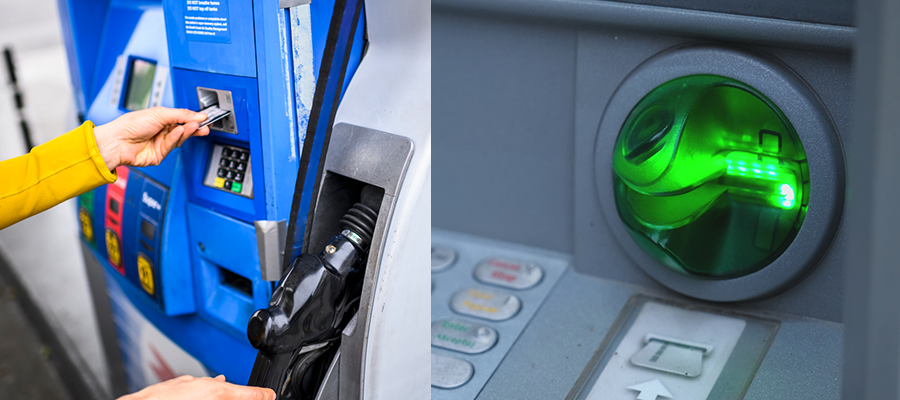
U.S. card skimming has increased by over 500% in the last two years with more than 161,000 compromised cards being impacted. Skimmers are used frequently at ATMs and fuel pumps because of their easy access and large usage. Skimming costs financial institutions and consumers more than $1 billion each year. A typical fuel pump skimmer can steal 30-100 cards in one day.
Here are examples of skimming and shimming methods:
ATM Skimming
A skimmer is a card reader disguised to look like part of the machine and is laid over the top of the real device to collect your card data. This attachment can read the data from the card as well as retain and record the PIN number by using a pinhole camera or by keylogging strokes.
Prevention Tips
- Inspect machines and card readers before using them.
- Pull the edges of the keypad to see if it moves or comes off.
- Do not use the card reader if you notice anything unusual.
- Use a machine you are familiar with in a well-lit location.
- Use only a debit or credit card with chip technology.
Fuel Pump Skimming
Fuel pump skimmers are usually attached to the internal wiring of the machine and are not visible to the customer. These skimming devices store data to be downloaded or wirelessly transferred.
Prevention Tips
- Choose a fuel pump that is closer to the station and in direct view of an employee. These pumps are less likely to be targets for skimmers.
- Run your debit card as a credit card. If that is not an option, cover the keypad when you enter your PIN.
- Consider paying inside rather than outside at the pump.
Shimming Devices
A shimming device is installed into a terminal’s payment device with enough room for a card to be inserted. It scans your card’s microchip and card information so it can be downloaded and used to commit fraud. These devices can be found at fuel pumps, ATMs, and vending machines. A shimming device is harder to spot than a skimming device due to its size and location. These devices also store data to be downloaded or wirelessly transferred.
Prevention Tips
- Pay inside at the fuel station.
- Use bank-owned ATMs.
- Inspect the card slot.
Once scammers receive card data from skimming or shimming, they will sell it or create counterfeit cards. Then, they purchase merchandise or withdraw cash as quickly as possible before the card is frozen.
Scammers are always looking for ways to make quick money. Keep up with current fraud trends to educate and protect yourself. If you suspect you have fallen victim to card skimming or shimming fraud, contact your bank immediately.
One way to protect yourself from card scams is to use Card Controls on your First Mid mobile app.
Resources
Banking Journal
FBI





